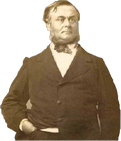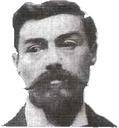Voici les différents panneaux du circuit patrimonial Mélusine :
Célébrités Vendeuvroises
The Renowned Figures of Vendeuvre
Do you know the famous people who conferred their names to some of our schools and streets?
POET BORN IN VENDEUVRE-SUR-BARSE

(1503–1550)
Nicolas BOURBON
His circle included François Rabelais and Hans Holbein, a painter and engraver whom he held in high regard and who sketched his portrait (see figure).
One of his earliest poems, ‘Ferraria’ (La forge), alludes to his origins and hometown, Vendeuvre, recognised for its forges and the manufacture of bombards (early cannons) since the 15th century. Today, his poem is an essential reference for those seeking to envision how a forge operated at that time.
He published his first poems in 1529, followed by the first edition of ‘Nugea’ (Bagatelles) in 1533, enticing the wrath of the religious authorities for portraying himself as favourable to the reformation.
This sufficed for him to be thrown into prison. He was not freed until early 1535 by King Francis I of France. Following his release, he journeyed to England and received the protection of Anne BOLEYN (second wife of Henry VIII).
Upon his return to France in 1536, he settled in Lyon where he socialised with a group of poets and humanists initially gathered around Etienne DOLET called the École lyonnaise.

Talented sculptors...
Considering the importance of the ‘Sainterie’ established by Léon MOYNET in Vendeuvre-sur-Barse, it is hardly surprising to find sculptors among the most prominent people of the town.

(1816–1875)
Joseph Théophile BOUTIOT
The son of modest farmers, he left school at the age of 12. Around 1840, leaving agriculture behind, he became a clerk at the city of Troyes Court. He took a great interest in geology, archaeology, geography, and history.
A member of the French National Geological Society, he was also a resident member of the Aube region Academic Society in 1852 and was appointed as president in 1872. His countless writings establish him as a renowned historian of Troyes and the southern Champagne region.
He did not overlook his native town in his research. This is displayed, in particular, in the following works: Geological essay on the Barse sources (1848), Le Valsurzeneth (1848), Historical information on Vendeuvre and its vicinity (1859–1860), and Biographical information on the Baron Pavée de Vendeuvre (1873).
Today, a nursery school bears his name in Vendeuvre.

(1854–1932)
Auguste Edmé SUCHETET
While his father, a builder, was working on the extension of the ‘Sainterie’ buildings, Léon MOYNET noticed the gifted young man and hired him as an apprentice sculptor. A few years later, convinced of his talent, he encouraged him to attend the Lyon School of Fine Arts.
In 1878, he received an honourable distinction at the Salon of French artists. He was awarded the Rome Prize in 1880 and made his debut at the Salon of Artists with ‘Biblis changée en source’ (a representation of Byblis), resulting in a three-year travel scholarship. He leaves us numerous works of art, including Le Rapt (1907) located on Place de la Libération in Troyes.


(1872–1912)
Ernest LEGRAND
Born in Lesmont, he attended the Troyes Design School, before being oriented to study design and sculpture in the Léon MOYNET workshop in Vendeuvre.
A talented sculptor, he pursued his education with Alfred BOUCHER (Camille CLAUDEL’s mentor). He had a distinguished career and was awarded the prestigious first prize from the Grand Prix de Rome for sculpture. Despite his short life, he produced an extremely prolific collection, including 10 pieces expressing the sensitivity and delicacy of a great artist, displayed in the Saint-Loup Museum in Troyes.






